St Joseph's College, Melbourne
| St Joseph's College Melbourne | |
|---|---|
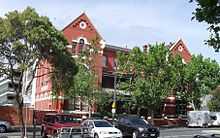 | |
| Location | |
|
Melbourne, Victoria Australia | |
| Coordinates | 37°48′14″S 144°57′17″E / 37.8039°S 144.9548°ECoordinates: 37°48′14″S 144°57′17″E / 37.8039°S 144.9548°E |
| Information | |
| Type | Independent secondary school for boys |
| Motto |
Luceat Lux Vestra (Latin: 'Let you light shine') |
| Established | 1903 |
| Founder | Irish Christian Brothers |
| Closed | December 2010 |
| Classes | Year 7 - 12 |
| Campus | North Melbourne and Pascoe Vale |
| Colour(s) | Purple, White, Gold & Blue |
| Affiliation | Roman Catholic, Christian Brothers, ACC |
St Joseph's College Melbourne opened early in 1903 and closed at the end of 2010. As a Roman Catholic secondary college, it was part of the Association of Edmund Rice schools, founded and run in the tradition of the Christian Brothers. Between the years 2000 and 2009 it operated two campuses, a senior campus (VCE and VET) located in Queensberry Street, North Melbourne, Victoria and a junior campus (Years 7 - 10), in Brearley Parade, Pascoe Vale, Victoria.
North
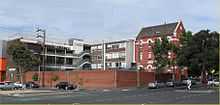
Throughout its life the school provided students, from a wide variety of cultural and economic backgrounds, with an opportunity to enter a range of careers. Many of its pupils went on to become respected members in their chosen fields which included the financial and business sectors, the medical profession, industry, sporting and religious communities.
While the two campuses lacked the open playing fields of its wealthier cousins, students had access to a range of local facilities. The North Melbourne campus for example, close to the Melbourne City Centre, was within walking distance of world class universities, museums, libraries, historical and athletic venues. Likewise the Pascoe Vale campus was able to make use of several nearby ovals and both were close to excellent public transport links.
Sport
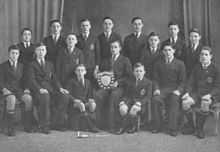
Sport was an important ingredient in the education of boys attending North. The school had its own football squad as early as 1906 when it played its first match against Christian Brothers College, St Kilda at Albert Park where it scored 2 points.[1] As enrollments grew then so did the involvement in other sports, often in competition with other schools. Inter school athletics, handball and tennis competitions, such as those conducted by the Associated Catholic Secondary Schools organization, were held as early as 1914 when the College won the Athletics Championship for that year. Membership to organizations such as that and also the Combined Secondary Schools group, around 1920, was one of key features of the schools early history.
From 1948 the school began its close involvement with the Associated Catholic Colleges, or ACC, where it won competitions in various sports over the years. Their famous 70 meter long banners, North is Speed, Power, and a cheer squad, led by the Committee organizing War cries, or COW,[2] where notable features of the annual competitions at the Olympic Park Stadium.
St Joseph's College students also became members of one of the schools sporting houses or teams. These built on the existing pastoral class groupings to generate team spirit during sporting carnivals with students wearing their team colors. These houses, later named after four early headmasters of the college, were:
Hogan McSweeney Geoghegan Kelly
College crest
At the time of amalgamation in 2000 a new logo was developed to represent the College. This logo was composed of pre-existing elements which were representative of the school's history and philosophy. Set on a traditional heraldic background, in the form of a shield, it features a rampant Gryphon protecting a smaller inner shield bearing a large shining star, a symbol used by the Christian Brothers, supported by smaller stars in the shape of the southern cross. The entire design sits above a ribbon which includes the words, "Luceat Lux Vestra".[3] The symbol appeared on the newly designed College uniform, which included a blazer after a lapse of a number of years, and various College medallions. The logo was used extensively on College publications and documents including Cynosura, the annual school magazine.
Associated schools
Over its long 107 year history the college was associated with a number of schools at one time or another. These included primary, or feeder schools, and higher secondary colleges. Although not exhaustive this list includes most of those known.
| - | Schools | - |
|---|---|---|
| St Oliver's (Pascoe Vale) | St Paul's (Coburg) | St Fidelis (Moreland) |
| St Mark's (Fawkner) | St Matthew's (North Fawkner) | St Thomas More's (Hadfield) |
| Corpus Christi (Glenroy) | St Joseph's (West Brunswick) | St Monica's (Moonee Ponds) |
| St Brendan's (Flemington) | St Augustines (Yarraville) | St Columba's Primary (Essendon) |
| Trinity College (Brunswick) | St Mary's (West Melbourne) | Cathedral College (East Melbourne) |
| Therry College (Broadmeadows) | St Thomas' (Clifton Hill) | St Joseph's (North Fitzroy) |
| St Joseph's Technical School (Abbotsford) | St Joseph's Technical School (South Melbourne) | St Kevin's College (Toorak) |
| St Ambrose's School (Brunswick) | ||
College history
1903-1930
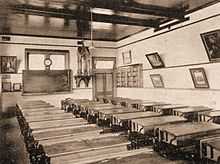
The College opened in 1903 with 44 students, rising to 112 by the end of that first year, and three Christian Brothers as staff. Students were divided into eight classes; Second, Third, Fourth, Fifth and Sixth, a Commercial Class, Sub-Matriculation and Matriculation Class. At that time the school was known as Christian Brothers' High School, North Melbourne.[4]
The first Principal was Br. William J Hogan, followed by Br. Francis A Kelly in 1904 and Br. Matthew A Geoghegan in 1908.[5] The first football team, featuring a large white star on its guernsey, was formed around 1906 and began a long tradition of involvement in a variety of sports. Early school Annuals indicate a variety of titles to identify the school and it was not until 1912 that the name "St. Joseph's" was added.[6] Even though its naming varied slightly over the years, the school was more simply known to its students as "North".
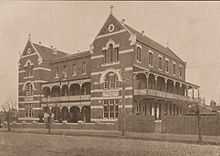
In 1913 the North Old Boys Association was formed [7] to assist the school in serving its expanding school population (200 pupils in 1909) and the increasing need for finances as the period after the First World War was an economically difficult one. In the early years both Primary and Secondary school classes were conducted on the Queensberry Street site. The school was able to achieve impressive educational results from its pupils in Junior and Senior University and Public Service Examinations as results published in early Annuals show.[8]
Between 1918 and 1941, students wishing to study for their Leaving Certificate had to do so at St. Kevin's College. By 1921 the enrollment stood at 174 and handball had become the leading sport as demonstrated by the construction of a concrete handball court which was considered to be of championship standard.

1940-1960
By 1940 the Christian Brothers' felt that the school had expanded to the point where it was able to take over the provision of night classes in a Catholic Accountancy school for young men in the Melbourne area. The classes started with 40 or 50 students but expanded, post war, to around 200 and provided study allowing its pupils to attain membership to the Australian Society Of Accountants. Hundreds of young men attended there until 1969 when the night school closed.[9]
1951 saw the first Matriculation class of 23 students graduate from the College which meant that it had attained full secondary school status.[10] During the Golden Jubilee year of 1953, 122 boys were members of the College Cadet unit and provided a martial spectacle as they paraded before visiting dignitaries. Arthur Calwell, a prominent politician and old boy, was a guest speaker on one occasion as was Archbishop Daniel Mannix.[11]
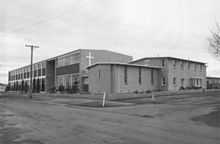
During the 1950s the growing school population, due partly to the post War migration boom, forced the college to purchase land and eventually build a second school in the suburb of Pascoe Vale. In 1956 the Preparatory College, as it was then known, opened under the guidance of Br. Ernest S Crowle as principal, who was himself an old boy of the College. In its early years it provided tuition in Grades 4, 5, 6 and Form 1 and had an initial enrolment of 274. By 1970 the school had become entirely secondary with classes comprising Form 1 to 4. Traditionally students completed their "junior" studies (Grades 7 to 10) at Pascoe Vale and then transferred to the "senior" campus in North Melbourne.
From its early beginnings the College was heavily involved in a range of sports and Australian Rules Football in particular. North's football teams were often considered tough opponents both within the local school competition and the Victorian Amateur Football Association (VAFA) as the North Old Boys Amateur Football Club, or NOB's, which it rejoined in 1964 after a lapse in membership. In 2005 the North club amalgamated with St Patrick's College, Ballarat to become North Old Boys St. Parick's College Amateur Football Club.[12]
1980-2010
During the later 1970s, 80s and into the 1990s, the site at Pascoe Vale South, with enrolments averaging around 490, took on a more independent identity to eventually be known as St. Joseph's College, Pascoe Vale. It had a separate administration, principal, School Board, registration number, logo and magazine, known as Scythia, to set it apart from its parent school, North.[13]
Beginning in 1997 preliminary discussions regarding the future of the two schools took place with a view to ensuring their continuing viability. The major issues included enrolments, student welfare, administrative structures, curriculum, staffing and finances. In 1998 the outcome of talks and independent reviews was that the schools should amalgamate within two years in order to remain a relevant and viable educational entity.[14]
The year 2000 saw the two sites formally amalgamated under a new name and banner to become the one College. It retained the traditional College colours of purple and white and College motto. A common uniform, which included a navy blue blazer with monogramed logo, became mandatory. In 2003 the student population was approximately 750 cared for by a single Principal, two Campus Directors and 92 staff.[15]
By 2008 the decision was made by Edmund Rice Education Australia (EREA) and the Christian Brothers to begin a phased closure of the College. The reasons behind the closure included falling enrolments (570 students),[16] amenities and plant which had become outdated and partly rundown and issues related to student management and involvement.[17] At the end of 2009 the Pascoe Vale campus closed and was stripped of any saleable assets leaving only the buildings. Those students who had stayed on were offered places at other Catholic schools for the continuation of their studies. Likewise, staff, if they wished, were seconded to other schools prior to being declared redundant at the end of 2010.
In 2010 extensive refurbishment work was carried out on the Pascoe Vale site by its new owners and later reopened as Saint Joseph Campus of Antonine College. At the end of the 2010 academic year the North Melbourne campus closed with a final Commemorative Mass and a range of ceremonies attended by current and past students and staff. In 2011 the site was temporarily closed as plans for a new learning center were formulated.
At the beginning of 2012 St. Joseph's Flexible Learning Centre opened at the old St. Joseph's site in North Melbourne. It is part of the Youth Plus Network managed by Edmund Rice Education Australia and is just one of many such centers around Australia. Its aim is to, provide young people with an opportunity to re-engage in education in a supported learning environment. [18]
Alumni
Australian rules football
'North' produced more than 50 Victorian Football League players, some of whom are listed below. A number of others also played with the Victorian Football Association, served as coaches or administrators.
- Stephen Alessio (Player with Essendon Football Club)
- Anthony Alessio (Australian Rules Footballer)
- John Barker (Australian rules footballer) (Player and coach with Fitzroy Football Club, Brisbane Lions Football Club and Hawthorn Football Club)
- Bob Bradley (Player with Essendon Football Club)
- Ray Brew (Player and past Captain of Carlton Football Club)
- Edward Considine (Player Essendon Football Club and Sydney Football Club)
- Gerry Donnelly (Player and past Captain of North Melbourne Football Club)
- Laurie Dwyer (Player with North Melbourne Football Club)
- Leo Dwyer (Player with North Melbourne Football Club)
- Kevin Dynon (College Captain 1940, Athlete, Player and past Captain of North Melbourne Football Club)
- Tom Fitzmaurice (Australian Football Hall of Fame)
- Anthony Franchina (Player with Carlton Football Club)
- Shannon Grant (Player with Sydney Football Club and North Melbourne Football Club)
- Jack Green (Player with Carlton Football Club and Hawthorn Football Club)
- Aaron Hamill (Player with Carlton Football Club)
- John Harvey (Australian Rules Football Umpire)
- Mark Hannebery (Player with Collingwood Football Club, amateurs Captain and Coach)
- Paul Koulouriotis (Player with Port Adelaide Football Club and Geelong Football Club)
- Allan La Fontaine (College Captain 1927,28,29, Player and past Captain of Melbourne Football Club)
- Shane Maguire (Australian Rules Football administrator)
- Jock McCorkell (Player with North Melbourne Football Club)
- Donald McDonald (Player, Assistant Coach and Administrator with North Melbourne Football Club)
- Bill Spurling (Player with Footscray Football Club)

Clergy
More than 100 boys were to become ordained priests representing ten different religious Orders. Of this number, four went on to become Bishops.[19]
- Matthew Beovich (Archbishop of Adelaide)
- Patrick Lyons (Bishop)
- John Aloysius Morgan (Bishop)
- John Scullion (Biblical scholar, writer)
- Bernard Denis Stewart (Bishop of Sandhurst)
General
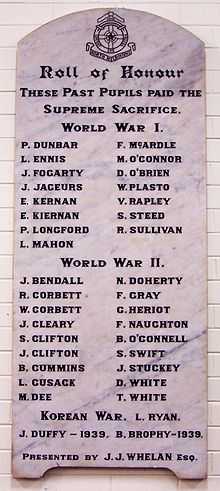
World War One servicemen - >75 (16 died on active service), World War Two servicemen - >780 (28 died on active service, 10 Prisoners of War)[20]
- Paul Coghlan (Judge of the Supreme Court of Victoria)
- William Cremor CBE (Army leader and Educationalist)
- John Hamilton (Professor, Melbourne University)
- Paul Lacava (Judge of the County Court of Victoria)
- Reginald Byron Leonard (Journalism, Army information service)[21]
- Leo Neal (First boy enrolled, first Dux and graduate, president of the first Past Pupils Association)
- Leslie McCarthy (One of the Colleges first students and lifetime benefactor)
- Leonard Ostrowski (Victorian County Court Judge)
- William Pitney (Leading haematologist and educator)[22]
- Bill and Kevin Spurling (Tailors and Formalwear business)
- Ron Tandberg (Journalist and Cartoonist)
- Ivo Vellar (Professor of Surgery, University of Melbourne)[23]
- Vincent Wardell (Business and Manufacturing, Encouraged production of the Owen Gun)
- James Joseph Whelan (Construction industry with Whelan the Wrecker also his sons Barry and Tony)
Politics and public service
- Thomas Brennan (Victorian state politician)
- Arthur Calwell (Former Opposition Party Leader)
- Francis Raymond Connelly (Former Lord Mayor of Melbourne)[24]
- Ahmed Fahour, CEO of Australia Post
- George Fewster (Victorian Politician)
- Sir James Gobbo (Former Governor of Victoria)
- Peter Kavanagh (Member of Victorian Parliament, Leader of DLP (Democratic Labour Party))
- Nick McKenna (Australian politician)
- Frank McManus (Politician)
- Bob Santamaria (Social commentator)
- Richard Wynne (MLA for Richmond)[25]
Sport
- Wayne Carroll (Basketball)
- Frank Casanelia (Horse racing)
- Phil Cleary (Sportsman and Social commentator)
- Tony Dodemaide (Test Cricketer - Australia)
- Jack Elliot (Leading Racing Journalist Melbourne Herald)
- Michael Ferrante (A-league Football Player)
- Paul Hibbert (Test Cricketer - Australia)
- Fred Italiano (Australian Champion Handball Player)
- Patrick (Paddy) Kelly (Horse racing - Leading jockey)
- Leo O'Brien (Test Cricketer - Australia)
- Andrew Nabbout (A-League Football Player for Melbourne Victory)
- Paul Stoddart (Business and sporting entrepreneur)
College Principals
|
|
School Song and War Cry
School Song
- Give a cheer for CBC, thro the years her fame has grown.
- Her grand ideals have enhanced her name,
- bearing fruit wherever seed is sown.
- Ev'ry rank and walk of life, has noble sons
- who'll e'er be true
- Ready to stand in peace and strife,
- beside the standard of purple and white.
- Purple and white are the colours we love,
- Excelsior they seem to say,
- And beckon us to reach the heights above.
- Faith gives her light with the torch burning bright,
- Its flame guiding us to do and dare,
- That North may be beyond compare.
by Br Bernard Murphy (1946)
War Cry
- Caddaburra, Wirracanna, Yarrawonga, Yah !
- Tallangatta, Wangaratta, Oodnadatta Aah !
- Nulla Gulla, Wulla Gulla, Wish Bang Wah !
- Cynosura, Cynosura, Yah, Yah, Yah !
- North, North, Yah, Yah . . N O R T H . . North !
- Caddaburra, Wirracanna, Yarrawonga, Yah !
- Tallangatta, Wangaratta, Oodnadatta Aah !
- Nulla Gulla, Wulla Gulla, Wish Bang Wah !
- Cynosura, Cynosura, Yah, Yah, Yah !
- North, North, Yah, Yah . . N O R T H . . North ![27]
See also
- Victorian Certificate of Education
- List of schools in Victoria
- Education in Australia
- Congregation of Christian Brothers
References
- ↑ Cynosura (Golden Jubilee edition 1953). North Melbourne, St Joseph's College
- ↑ North 1980. (St. Joseph's College Magazine, First publication since 1953) North Melbourne, St Josephs, North Melbourne
- ↑ St Josephs College Melbourne 2000. (magazine) St Josephs College, North Melbourne
- ↑ Christian Brothers' High School, North Melbourne. The Advocate 26 December, 1903. Page 15. Retrieved on 9 March, 2015 from http://nla.gov.au/nla-news-article169747880
- ↑ Stewart, Ronald (2000) The Spirit of North 1903-2000. North Melbourne, St. Joseph's College Melbourne
- ↑ Christian Brothers' College, St. Joseph's, North Melbourne. The tenth annual report. North Melbourne, 1912
- ↑ Stewart, Ronald (2000) The Spirit of North 1903-2000. North Melbourne, St. Joseph's College Melbourne
- ↑ Christian Brothers College, St Josephs, North Melbourne: The Tenth Annual Report, Prospectus and Prize List. CBC, North Melbourne
- ↑ Cynosura (Golden Jubilee edition 1953). North Melbourne, St Joseph's College
- ↑ Stewart, Ronald (2000) The Spirit of North 1903-2000. North Melbourne, St. Joseph's College Melbourne
- ↑ Cynosura (Golden Jubilee edition 1953). North Melbourne, St Joseph's College
- ↑ http://australianfootball.com/clubs/list/Local/VIC
- ↑ Stewart, Ronald (2000) The Spirit of North 1903-2000. North Melbourne, St. Joseph's College Melbourne
- ↑ Stewart, Ronald (2000) The Spirit of North 1903-2000. North Melbourne, St. Joseph's College Melbourne
- ↑ Cynosura 2003 (Centenary Edition) St Josephs College Melbourne, North Melbourne
- ↑ Cynosura 2008. St Josephs College Melbourne, North Melbourne
- ↑ Smith, Anthony (2010) The Spirit Continues 2000-2010. North Melbourne, St. Joseph's College Melbourne
- ↑ Edmund Rice Education Australia (2011) Flexible Learning Centre. Retrieved on 1 September 2012 from http://www.erea.edu.au
- ↑ Stewart, Ronald (2000) The Spirit of North 1903-2000. North Melbourne, St. Joseph's College Melbourne
- ↑ Talbot, Christopher.(2014). Northern Sons under the Southern Cross. [Blog entry] Retrieved on 1 January 2014 from http://christal.edublogs.org/2013/02/23/northern-sons-under-the-southern-cross/
- ↑ Kilpatrick, Rod (2012) Leonard, Sir Reginald Byron (1907-1986). Australian Dictionary of Biography Vol. 18 MUP, 2012
- ↑ Carmody, John (2012) Pitney, William Robert (1921-1986). Australian Dictionary of Biography Vol.18. MUP, 2012
- ↑
- ↑ David Dunstan, 'Connelly, Sir Francis Raymond (1895–1949)', Australian Dictionary of Biography, National Centre of Biography, Australian National University, http://adb.anu.edu.au/biography/connelly-sir-francis-raymond-9809/text17341, published in hardcopy 1993, accessed online 8 June 2014
- ↑ http://www.parliament.vic.gov.au/members/id/173
- ↑ Kozlowski, Jolanta (2010) List of Past Principals. (archival research notes) North Melbourne, St. Joseph's College Melbourne
- ↑ Stewart, Ronald (2000) The Spirit of North 1903-2000. North Melbourne, St. Joseph's College Melbourne
External links
- A new life for North ! - North Melbourne Flexible Learning Centre
- Edmund Rice Education Australia website
- North Old Boys St Patricks College Amateur Football Club
- Brief history of Australian Handball